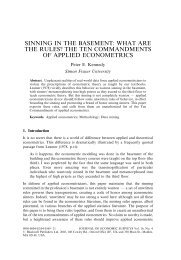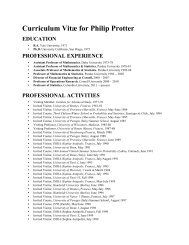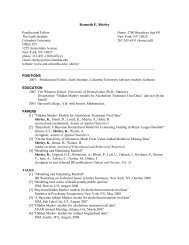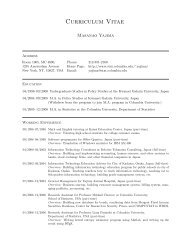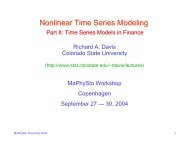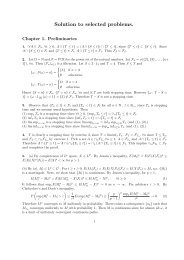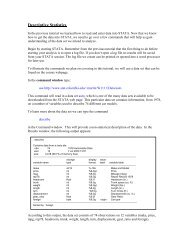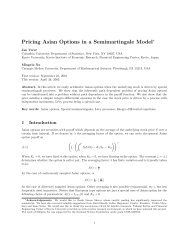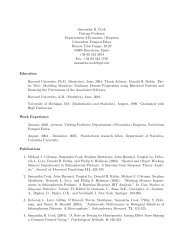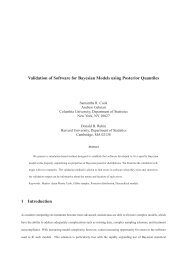The Self-Controlled Case Series - Department of Statistics ...
The Self-Controlled Case Series - Department of Statistics ...
The Self-Controlled Case Series - Department of Statistics ...
Create successful ePaper yourself
Turn your PDF publications into a flip-book with our unique Google optimized e-Paper software.
4 D. Madigan et al.<br />
Safety Datalink provides an early example <strong>of</strong> a LOD specifically designed for<br />
safety. Papers focusing on drug safety include Curtis et al. (2008), Jin et al.<br />
(2008), Kulldorff et al. (2008), Li (2009), Noren et al. (2008), and Schneeweiss<br />
et al. (2009).<br />
3. THE SELF-CONTROLLED CASE SERIES METHOD<br />
Farrington (1995) proposed the self-controlled case series (SCCS) method in<br />
order to estimate the relative incidence <strong>of</strong> adverse events to assess vaccine<br />
safety. <strong>The</strong> major features <strong>of</strong> SCCS are that (1) it automatically controls for<br />
time-fixed covariates that don’t vary within a person during the study period,<br />
and (2) only cases (individuals with at least one event) need to be included<br />
in the analysis. With SCCS, each individual serves as their own control. In<br />
other words, SCCS compares outcome event rates during times when a person<br />
is exposed versus outcome event rates during times when the same person is<br />
unexposed. In effect, the cases’ unexposed time lets us infer expectations<br />
about what would have happened during their exposed time had they not<br />
been exposed.<br />
SCCS is one <strong>of</strong> several self-controlled methods that the epidemiology literature<br />
describes, many <strong>of</strong> which are variants on the case-crossover method<br />
(Maclure, 1991). However unlike the case-crossover method, which typically<br />
requires the choice <strong>of</strong> a comparator time period to serve as a control, SCCS<br />
makes use <strong>of</strong> all available temporal information without the need for selection.<br />
Epidemiological applications <strong>of</strong> SCCS tend to focus on situations with<br />
small sample sizes and few exposure variables <strong>of</strong> interest. In contrast, the<br />
problem <strong>of</strong> drug safety surveillance in LODs must contend with millions <strong>of</strong><br />
individuals and millions <strong>of</strong> potential drug exposures. <strong>The</strong> size <strong>of</strong> the problem<br />
presents a major computational challenge – ensuring the availability <strong>of</strong> an<br />
efficient optimization procedure is essential for a feasible implementation.<br />
3.1. One drug, one adverse event<br />
We will first focus on the case where there is one drug (e.g. Vioxx) and one<br />
adverse event (e.g. myocardial infarction, MI) <strong>of</strong> interest.<br />
To set up the notation, i will index individuals from 1 to N. Events and<br />
exposures in our databases are recorded with dates, so temporal information<br />
is available down to the level <strong>of</strong> days (indexed by d). Let τ i be the number <strong>of</strong><br />
days that person i is observed, with (i,d) being their dth day <strong>of</strong> observation.<br />
<strong>The</strong> number <strong>of</strong> events on day (i,d) is denoted by y id , and drug exposure is<br />
indicated by x id , where x id = 1 if i is exposed to the drug on (i,d), and 0<br />
otherwise.<br />
SCCS assumes that AEs arise according to a non-homogeneous Poisson<br />
process, where the underlying event rate is modulated by drug exposure. We



